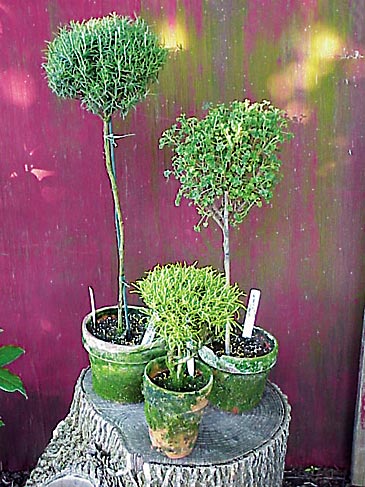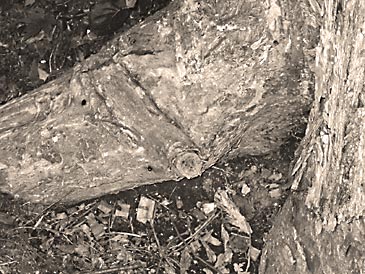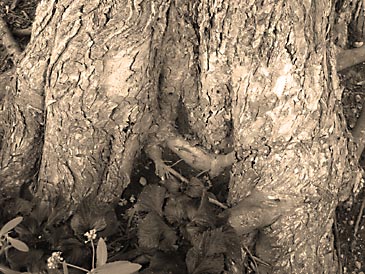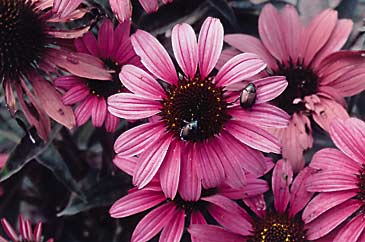 Jean and Roxanne Riggs
Jean and Roxanne Riggs
Herbal topiaries – rosemary, scented geranium and santolina.by Jean and Roxanne Riggs
As more and more people are discovering the joys of gardening in containers, both indoors and in the garden, the use of herbs in the containers has also grown in popularity. Many of the woody-stemmed herbs are especially well-suited to being grown and trimmed into artistic shapes, and the grower is doubly rewarded with a beautiful plant that can be fragrant and useful in the kitchen. Herbal topiaries require time and commitment but are among the most lovely of all potted plants. They let the herb gardener experience different plant habits and needs, along with developing creative ways to display a natural herb.
How to plant and maintain a topiary
Herb plants that are to be trained into topiaries will need the best care that you can give them. Adequate light is important, so plan on giving them at least 5 hours of sunlight a day. They must have sunlight or grow lights during the winter months when they are indoors. Pay attention to the soil in which you are growing them and make sure they have excellent drainage. Clay pots with holes in the bottom are very useful as they help with drainage; you can line the bottom inch of the pot with stones or broken pot pieces to make it even better. One of the high quality soilless mixes available at garden centers is the best choice for a growing medium. Once the plant is established and growing well, you will have to fertilize it regularly since plants grown in containers have no way of getting nutrients unless you add them. A slow-release fertilizer is recommended. Watering is very important; if the soil gets dry to the touch, you must water thoroughly. Relying on the rain will not work and you cannot sit the pot in water or it will rot the roots. Misting encourages molds and mildew on leaves. A good drenching with a watering can or watering wand attached to a hose will really do the job. In cold climates, herbal topiaries are not hardy and must be kept in good growing conditions year round. Topiaries should be moved inside before the first frost in the fall. The ideal temperatures would be 65 degrees or higher in the daytime, and 55 degrees or higher at night.
Herb plant choices
Herb plants that make good candidates to be grown artistically include most of the woody-stemmed varieties:
• Rosemary (Rosmarinus officinalis) for the upright topiaries and prostrate rosemary (R. officinalis ‘Prostratus’) for training into the more intricate shapes like hearts and circles, as well as bonsai.
• Lavender (Lavandula angustifolia, L. lanata, L. dentata and others) although the constant removal of the tips to shape the topiary may eliminate the flowers.
• Thyme (Thymus) has upright varieties that are very good for people with limited space because of their small size.
• Germander (Teucrium) with its tiny fragrant leaves that resemble oak leaves.
• Sage (Salvia officinalis) in its many colored varieties or pineapple sage (Salvia elegans) with its fruity aroma.
• Lemon verbena (Aloysia triphylla) with its strong, sweet lemon fragrance and flavor—just imagine the shocked look on the faces of your guests when you pick a leaf from your prized topiary to flavor your tea!
• Myrtle (Myrtus communis) in its compact or variegated forms.
• Bay (Laurus nobilis) which is a classic shape and the largest of the plants listed here.
• Savory (Satureja montana) has shiny leaves and good taste; reputed to have been named after “satyr” for its aphrodisiac qualities.
• Scented geranium (Pelargonium) with its many varieties, although we recommend that you stay with the smaller-leaved types. Don’t bother with annuals since their short life span makes it foolish to spend your time pruning and trimming.
Creating your topiary
Many of the above plants come in beautiful variegated leaf varieties. However, we stay away from the yellow-leaved types since they sometimes look sick or uncared for in this type of use. Select young plants, from a reliable herb farm or nursery, that are tall and have a straight center stem if you want them to grow upright into the lollypop or poodle shape, or lax and trailing stems if you want them to grow on a wire form. The new plant should be transferred into a 4- or 5-inch clay pot with the soilless mix after purchase.
To start the single ball topiary, which consists of foliage clipped into a tight ball on the top of a sturdy stem, you should begin trimming the lowest leaves and branches. At least 1/3 of the plant’s foliage must remain so it will continue to grow and thrive. Keep doing this until the plant has grown to the height you want it. When the proper height is achieved, pinch the tip off. Place a bamboo stake that is just shorter than the plant into the pot to keep the plant stem straight. Use a few twist ties to loosely attach it to the stake, but don’t strangle the plant as it grows. Now cut off the bottom branches and clip the other branches to start the shape of the ball. During this part of the training process, the plant looks less than lovely. However, it will quickly fill in with new leaves and small branches and look like the art work you had in mind when you started. The same things should be done for the other shapes too, like the double ball or the cone, keeping in mind the ultimate shape and form that you want the plant to achieve. If you make a mistake (and who doesn’t?) don’t worry, the plant will grow back and give you a second chance. It just might take a little longer.
Tools that help
Even the beginner needs some basic tools to use. A really good, sharp pair of garden scissors is a great asset. Be prepared to spend $20 to $45 for these. Stay away from the large pruners for now. A pair of garden tweezers is handy for removing dead leaves and other debris. Bamboo stakes or a preformed topiary wire shape are necessary right from the start since the selection of the plants to be used depends on what the ultimate size and shape of the topiary will be. Plant ties or twist ties, preferably green, that can be cut to the sizes necessary are essential. For some of the heavier stems it might be necessary to use a wire to keep the shape desired. Clay pots are good and are heavy enough to support the taller topiaries. If the wind blows one over, double pot the plant with a second pot at least two to three inches larger than the interior pot. Layer the bottom of the outer pot with pebbles, and fill the sides with the pebbles after the interior pot has been placed into the second pot. Another trick is to run a longer bamboo stake through one of the drainage holes and down into the ground to keep them from blowing about too much.
If you are going to give one of your beauties away as a gift, be sure to include a “care tag” for the lucky recipient. Include the name of the plant and a recipe if it is a culinary herb, and basic care instructions of light, water, temperature, and clipping so that they will enjoy their topiary for a long time.
Jean and Roxanne Riggs operated Sunshine Farm and Garden in Commerce Township, MI.



